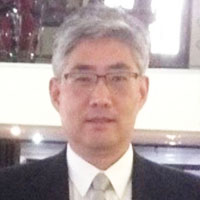By Byong Kwon
Thanks to generous support from the United States Agency for International Development (USAID) and Arizona State University (ASU), I lived in Bogotá, Colombia to conduct my doctoral research from August 2016 through April 2018. Although my USAID project in Colombia was longer and more research-intensive than the brief USAID projects in which I previously participated—Tanzania in 2013 and El Salvador in 2016—my takeaways were the same from these different countries. First, the applied mathematics and computational sciences communities can significantly impact developing countries. Second, even a few people can make a big difference in these countries. Last, we should focus on empowering local experts, as they understand the most pressing development needs better than outsiders from developed countries.
In Colombia, I researched robotic control algorithms for humanitarian demining robots. After the 2016 peace deal ended a 52-year civil war with the largest Marxist rebel group in Colombia, humanitarian demining was important so that displaced refugees could return to and revive post-conflict areas. I spent most of my time learning about the demining problem with the Colombian National Army (COLAR). Before working with COLAR, I had naively believed that graph-theoretic tools for robot path planning and machine learning for mine detection would lead to tractable demining solutions. But the COLAR experts kindly explained the demining “reality gap” — many demining solutions proposed by commercial providers and university researchers did not work or were impractical in the field. For example, the first top-of-the-line demining metal detectors that COLAR acquired did not function properly because many Colombian soil types are highly metallic, so the manufacturer had to calibrate the detectors specifically for Colombia. However, the rebel groups eventually changed their tactics and produced mines with few or no metal parts; criminal and rebel groups continue to plant mines and adapt their tactics to vitiate new mine detection technologies or countermeasures.
From left: then-Lieutenant Colonel Carlos Alberto Betancur, Byong Kwon, and then-Commanding General Alberto José Mejía at the Escuela de Caballería reception in July 2017. Image courtesy of Byong Kwon.
Besides adaptive adversaries, equipment size, weight, and power are key constraints that hinder demining technologies because many areas to be demined are inaccessible by road. As a result, mules or people must carry equipment and supplies into remote areas. In addition, many demining technologies require skilled operators with advanced training, and the equipment is expensive to maintain. Given the foregoing factors, humanitarian demining in Colombia substantially consists of manual probing and removal of mines.
Unfortunately, Colombia has insufficient science, technology, and innovation (STI) capacity to address its difficult demining problem and larger sustainable development goals. According to the United Nations Educational, Scientific and Cultural Organization’s Institute for Statistics, Colombia only had 88 researchers in research and development per one million people in 2016. For comparison, the number of researchers per one million people was 550 in Latin America and the Caribbean as of 2017, 4,047 in the member countries of the Organisation for Economic Co-operation and Development as of 2015, and 1,450 in the world as of 2015. To increase STI capacity for demining and other problems that COLAR faces, General (Ret.) William Fernando Pérez Laiseca, Colonel Carlos Alberto Betancur Paniagua, Camilo Triana Delgado, and I proposed to launch a COLAR STI officer program called the Equipo de Líderes en Investigación y Tecnología del Ejército (ÉLITE). In South America, the military is a critical partner to address many development goals because it is one of the few organizations with sufficient funding, logistics, manpower, and equipment to build, operate, and maintain supply chains and infrastructure in remote areas.
Project ÉLITE was inspired by Talpiot—the Israel Defense Forces STI officer program—wherein top recruits undergo advanced military training over the course of 36 months and pursue an undergraduate degree in mathematics, physics, or computer science at the Hebrew University of Jerusalem, with an emphasis on teamwork and experiential learning. Talpiot, which launched in 1979, has slightly more than 1,200 graduates to date; these graduates have been essential in developing critical technologies and catalyzing a vibrant commercial technology sector in Israel. Among the Talpiot alumni is Israel’s first Fields Medalist: mathematician Elon Lindenstrauss, who is a professor at the Hebrew University.
Like Talpiot, Project ÉLITE envisions that top COLAR recruits will obtain applied mathematics or physics degrees at a Colombian university, conduct one-year research internships at U.S. military research laboratories, and ultimately serve as STI officers in COLAR units. Before leaving Colombia, I met Commanding General Alberto José Mejía Ferrero, who enthusiastically supported ÉLITE. However, the pilot project for ÉLITE failed to proceed after the Colombian presidential administration changed in August 2018. Given that a new Colombian presidential administration will commence in 2022, my COLAR friends hope to revive Project ÉLITE and build STI capacity in Colombia.
Moreover, their timing to build such capacity is opportune. Colombia, Venezuela, and Central America are key foreign policy priorities in the Americas for the new Biden-Harris administration. The U.S. administration is expected to increase development and humanitarian aid for Colombia to address remaining post-conflict issues and the influx of Venezuelan refugees. For Central America, the administration intends to commit U.S. $4 billion in development aid to address the root causes of Central Americans’ migration to the U.S. Given that capital and resources are limited in developing countries, local applied mathematics and computational science skills are needed because many development goals inherently are difficult resource allocation problems. As the Biden-Harris administration re-engages the U.S. in the Paris Climate Agreement, World Health Organization, and the United Nations’ Sustainable Development Goals, I encourage SIAM members in the U.S. and other developed countries to take advantage of the return of U.S. multilateral diplomacy and participate in international capacity development if they have not yet done so.
 |
Byong Kwon (BK) is a postdoctoral researcher at the University of Arizona and served as a USAID-ASU Global Development Research Scholar in Colombia from May 2017 through April 2018. |